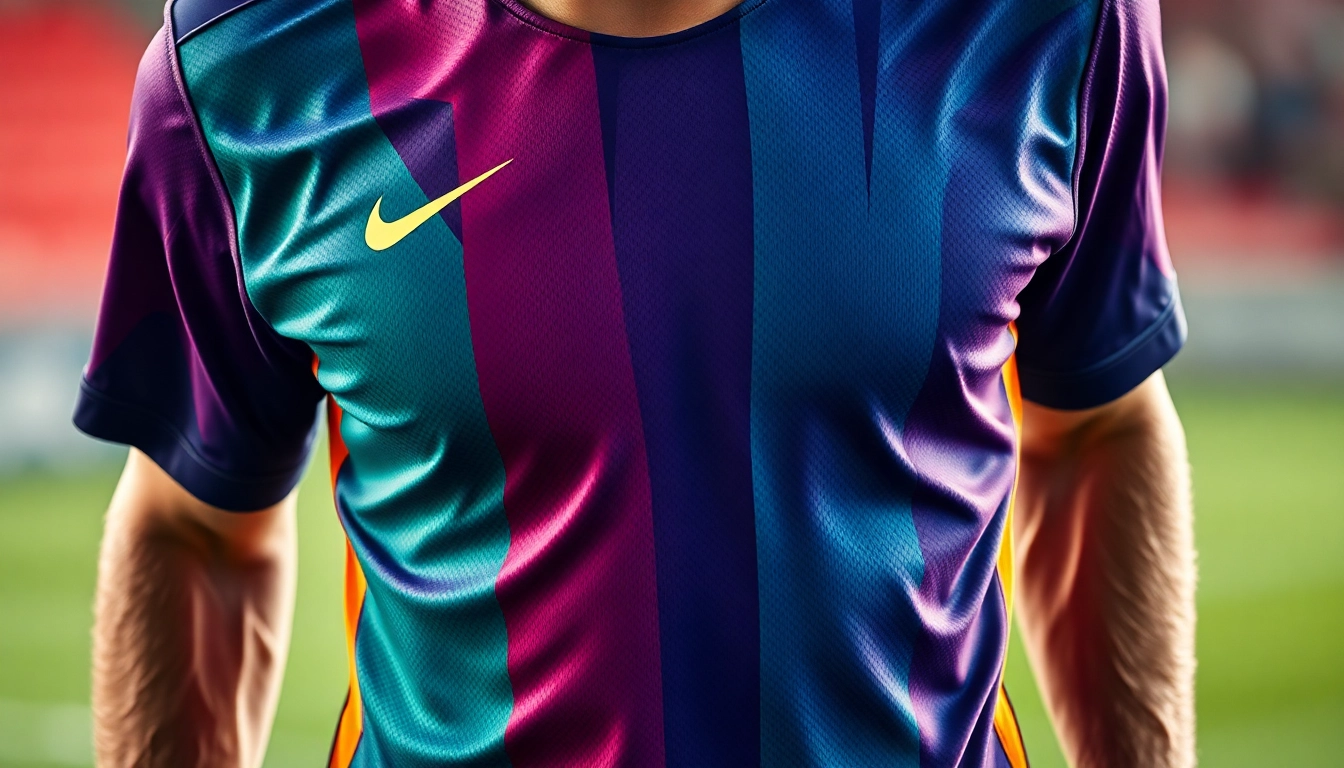Understanding the Basics of Soccer Uniforms
Soccer uniforms are an integral part of the sport, serving both functional and aesthetic purposes. From historical roots to modern technology, the evolution of soccer gear reflects advancements in performance, team identity, and player comfort. For enthusiasts, coaches, and team managers alike, understanding the foundational aspects of soccer uniforms is essential to making informed choices that can impact gameplay and team cohesion. Whether you’re outfitting a youth team or a professional squad, selecting the right equipment starts with knowledge of the components and materials that define high-quality soccer gear.
For a comprehensive selection of top-tier Soccer Uniforms, exploring diverse options tailored to varied needs and budgets is crucial. In this guide, we’ll delve into the history, components, material choices, customization options, and cutting-edge innovations shaping today’s soccer apparel landscape.
History and Evolution of Soccer Gear
The origins of soccer uniforms trace back to the late 19th century, where players typically wore standard woolen shirts and heavy cotton shorts. As the sport grew in popularity, the need for specialized, lightweight, yet durable apparel became evident. The initial focus was on simple, functional designs, but over time, technological advancements revolutionized soccer gear.
In the 20th century, synthetic fabrics like polyester replaced traditional materials, offering better moisture management, durability, and ease of maintenance. The introduction of advanced fabric technologies, such as moisture-wicking and breathable meshes, significantly enhanced player performance. Moreover, custom team branding, including logos and unique color schemes, became prominent, reflecting team identity and fostering camaraderie.
Today’s soccer uniforms are the result of decades of innovation, blending performance-enhancing fabrics with stylish designs that cater to both players’ needs and fan preferences. The evolution continues with sustainable materials and smart textiles promising even further improvements in comfort and environmental responsibility.
Components of a Standard Soccer Uniform
Jersey
The jersey is the central visual element of a soccer uniform, typically made from lightweight, moisture-wicking fabrics like polyester blends. It features critical design elements such as team colors, numbers, and sponsor logos. Modern jerseys may incorporate ventilation zones for enhanced breathability during intense play.
Shorts
Soccer shorts are designed for mobility and comfort, often made from elastic, quick-drying materials. They usually feature reinforced stitching and adjustable waistbands to accommodate different body types and ensure a secure fit.
Socks
High-performance soccer socks provide compression, support, and moisture management. They help prevent blisters and improve circulation. Some models include graduated compression zones to enhance muscle recovery post-match.
Additional Accessories
Optional elements such as goalkeeper jerseys, compression shirts, and protective gear like shin guards complement the basic uniform elements, offering added protection and customization based on player roles.
Material Choices and Their Impact on Play
Material selection is crucial to the functionality of soccer uniforms. The most common fabrics include polyester, nylon, and elastane blends, engineered for optimum performance. Features to consider include breathability, moisture-wicking, durability, and elasticity.
Polyester-based fabrics dominate the market due to their lightweight nature and excellent moisture management capabilities. Advanced textile technologies such as Dri-FIT (by Nike) or ClimaCool (by Adidas) incorporate microfibers that draw sweat away from the skin, promoting rapid evaporation and keeping players dry and comfortable.
Fabric durability is equally important, especially for youth and amateur leagues, where uniforms endure frequent washing and rough handling. Eco-friendly and sustainable materials are gaining popularity, with brands adopting recycled polyester and organic cotton to reduce environmental impact without sacrificing performance.
Design & Customization for Your Soccer Team
Popular Patterns, Colors, and Branding Options
Team branding is a powerful tool to foster unity and pride. Teams often select colors that represent their identity, while patterns such as stripes, gradients, or sublimated graphics add visual appeal. Custom logos, sponsors, and player names further personalize uniforms, making them distinctive on and off the field.
How To Customize Your Soccer Uniforms
Customization typically involves selecting fabric, color schemes, and design elements through a professional vendor or online platform. Many providers offer templates that can be modified or entirely bespoke designs created from scratch. Printing techniques like sublimation allow vibrant, long-lasting images without impacting fabric flexibility. Placement of logos, names, and numbers is carefully considered to optimize visibility and brand consistency.
Advantages of Personalized Uniforms for Team Identity
Customized uniforms create a unified appearance, foster team spirit, and boost morale. They also serve as an effective marketing tool for sponsors and promote professionalism. Unique designs can attract attention, making your team memorable among spectators and opponents alike.
Choosing the Best Soccer Uniforms for Performance
Features of High-Performance Soccer Jerseys
Elite soccer jerseys incorporate features such as lightweight construction, stretch fabrics for unrestricted movement, and seamless or flatlock stitching to reduce chafing. Ventilation zones or mesh panels are strategically placed to enhance airflow, especially under high-intensity conditions.
Fabric Technologies Enhancing Comfort and Durability
Manufacturers employ innovative technologies like anti-odor treatments, UV protection, and enhanced elasticity. Recycled polyester and other eco-friendly materials now add sustainability to performance — demonstrating that high-quality gear can also be environmentally responsible.
Selecting the Right Fit for Different Ages and Skill Levels
Proper fit is essential for optimal performance. Youth players require slightly looser fits to accommodate growth, while adult players benefit from tailored, form-fitting designs that reduce drag. Understanding size charts and trying on different styles helps in choosing the most comfortable and functional options for each player.
Maintaining and Caring for Soccer Uniforms
Proper Washing and Storage Tips
To prolong the life of soccer uniforms, wash them in cold water using mild detergents, preferably without bleach. Turning jerseys inside out minimizes fading and fabric abrasion. Avoid fabric softeners, which can diminish moisture-wicking properties. After washing, air-dry or tumble dry on low heat, ensuring uniforms retain their elasticity and color vibrancy.
Replacing and Upgrading Your Team Gear
Regular assessment of uniform condition is critical. Look for signs of wear such as fading, tearing, or loss of fabric elasticity. Upgrading should also consider new technological advances in fabric performance, ensuring your team benefits from the latest innovations.
Ensuring Longevity of Quality Soccer Uniforms
Proper storage in a cool, dry place and avoiding prolonged exposure to sunlight help maintain fabric integrity. Rotating uniforms for matches and laundering after each use also extend their lifespan, ensuring your investment remains competitive over multiple seasons.
Top Trends and Innovations in Soccer Uniforms
Latest Fabric Technologies and Design Trends
Design trends gravitate towards sleek, minimalist aesthetics combined with advanced fabric technologies. Companies experiment with 3D printing for logos and personalized graphics, while seamless construction improves comfort. Color-blocking and sublimation techniques create vibrant, dynamic looks that stand out on the pitch.
Sustainable and Eco-Friendly Materials
Environmental responsibility is a growing priority in the sports apparel industry. Recycled polyester, organic cotton, and plant-based dyes are becoming standard choices. Brands like Adidas and Nike lead the way, integrating green practices without compromising performance or style.
Future Developments Shaping Soccer Apparel
Emerging innovations include smart textiles integrated with sensors to monitor player metrics such as heart rate and hydration levels. Additionally, bio-engineered fabrics aiming for ultra-lightweight durability and self-healing properties are on the horizon, promising to redefine soccer uniform standards.


